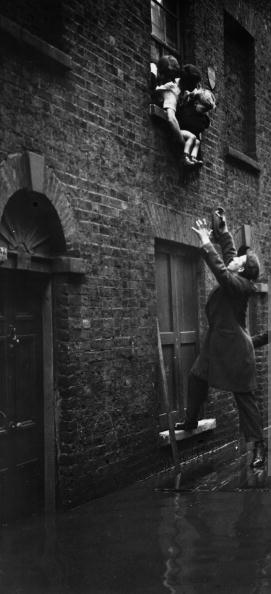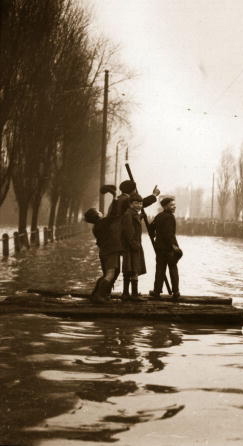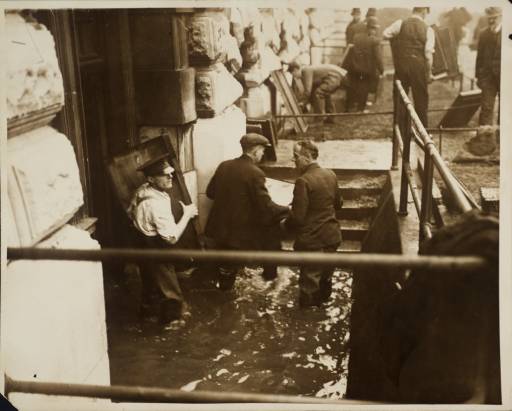Tags
1928, art, artwork, bridge, british art, flood, john soane, lambeth, lambeth bridge, london, mud, rare meats, restaurant, rex whistler, river, ruin lust, ruins, slums, tate, tate britain, tate gallery, thames, thames barrier, turner, westminster
On a recent visit to the Tate Britain gallery, on the north side of the Thames, we saw the excellent Ruin Lust exhibition, which charts artistic reactions to ruins, and the idea of ruins, through time. One of the show’s most striking pieces is Joseph Gandy’s Destruction of the Bank of England, a mammoth pen and ink drawing of 1830 which imagines Sir John Soane’s bank fallen into desuetude at some future point in time. Fascinatingly, Sir John commissioned the work himself, in what is usually considered an assertion of his own greatness as an architect. It is thought to have been his way to tell the world that he was worthy of consideration alongside the greatest designers of classical antiquity.
After the exhibition, we visited the Tate’s fine subterranean restaurant, which boasts a famous four-wall mural by Rex Whistler: The Expedition in Pursuit of Rare Meats. The mural, which dates from 1927, is a light-hearted celebration of hunting, and is full of artistic references and knowing nods to the then management of the Tate and to Britain’s wider 1920s arts establishment. Its base colour is a soft, cool green, which is reflected beautifully in the restaurant’s black floor and columns, and which bathes the entire space in a relaxing, pastoral light.
Whistler’s work contains depictions of several buildings, but, for the most part, they are intact and idealised ones – not ruins. Nonetheless, it is a little-known fact that the mural itself may, in one sense, be considered a ruin, or at least a survivor from a very significant act of destruction. The Expedition in Pursuit of Rare Meats was formally unveiled at a gala reception at the Tate on 30 November 1927, in the presence of, among others, George Bernard Shaw and Sir Henry Tonks. But just six weeks later, in January 1928, it found itself entirely submerged – many feared destroyed – by the last (to date) of London’s great floods.

Just as modern-day weather can, it made the inhabitants of London, one of the leading world cities, feel suddenly vulnerable.
The Thames flood of 1928 was the result of a combination of natural and man-made factors – just like the floods that have affected Britain in recent years. Dredging in the early twentieth century had made it easier for seawater from the North Sea to flow rapidly up the Thames at high tides. On the night of 6/7 January 1928, the flow from a particularly high tide mingled with meltwater from an unusually heavy and quickly-thawing snowfall in the Cotswolds.
The results were disastrous. From the City and Southwark in the east to Putney and Hammersmith in the west, the Thames burst its banks, overflowing the impressive granite walls that had been put there by nineteenth-century engineers to contain it. Around Lambeth bridge, large parts of the embankment washed away altogether, allowing a wall of water to race through Westminster’s and Lambeth’s slums. In total, in the course of just a few hours, fourteen people died, all of them unsuspecting inhabitants of basement flats, who were drowned in their sleep; some 4,000 others were rendered homeless. Meanwhile, the Houses of Parliament flooded and the moat of the Tower of London briefly refilled.
According to The Times for Monday 9 January, the impact on the capital was little short of a catastrophe. Poignant stories proliferated. “Two young women were drowned in a flat at Putney and two servants living alone in a house at Hammersmith were drowned in their bedroom, having been unable to attract attention to their plight,” the paper said. At Westminster, “the scene of the most violent and extensive flooding”, “ten other persons” had been killed. The youngest was just two-and-a-half – Doris Harding of Grosvenor Road – while the eldest, Jane Hawley, aged 72, had been an inhabitant of a property located some 50 metres from the riverbank.
Among the many institutional casualties, the Tate fared worst. The embankment immediately in front of its doors collapsed, ushering water and mud into its basements, and submerging much of its unique collection of drawings and watercolours by J. M. W. Turner. Already before dawn, Tate employees were rushing from across London to the scene, and they proceeded to spend the rest of the day, in freezing conditions, rescuing precious works of art, and ferrying them to the British and Victoria and Albert museums to dry. In the course of the salvage operation, the gallery’s director, Charles Aitken, was to be seen wading back and forth continuously through the icy floodwaters, at one point even disappearing into an open manhole in what were treacherous conditions (see The Times, Letters to the Editor, 16 January 1928).
In the chaos, everyone assumed that Rex Whistler’s murals were lost. Artistically insignificant by comparison with the Turners (to 1920s eyes at least), they were not removable in any event, and so had to be left to the mercy of the flood. When Tate staff finally re-entered the Refreshment Room three days after the deluge their eyes were first met by a space littered with smashed crockery and broken chairs and tables, and a mural that was variously caked in and glistening with mud. It would have been easy to think that the entire ensemble had been ruined.
However, thanks to a pioneering new method of painting, the Expedition survived. Whistler had used a mixture of wax and turpentine to glaze, or varnish, his work, intending by this to protect it from the food, drink and tobacco stains that it might otherwise attract in its restaurant setting. Amazingly, this glaze proved sufficient to prevent the river water from coming into contact with the paint, too. Consequently, after some washing, and to general delight, the mural ended up looking pretty much as good as new.
In fact, today, as you eat and drink in its presence, you would never even guess it had come so near to destruction. The Tate’s website mentions the 1928 flood in several places, including in a recent blogpost, which describes the flood’s impact on the mural. But I think it would be nice if the restaurant itself commemorated the event in some way – especially while the Ruin Lust exhibition is running. For me personally, learning about the flood only made the experience of sitting in the midst of Whistler’s early masterpiece all the more precious.





Reblogged this on First Night History.
A lucky scape indeed